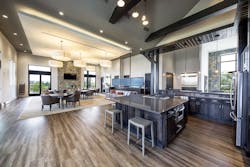6 Considerations for 55-Plus Home Design
Boomers are redefining aging by trading in early-bird specials for fine dining, cafeterias for locally sourced coffee shops, and “senior housing” for “active lifestyle.” So can redesigning the physical environment for seniors redefine aging itself? Here are six considerations for 55-plus home design:
1. Similarities with Other Life Stages
Boomers value much of the same amenities and features as Generation X, Generation Y, and Millennials, such as open concept floor plans with great rooms and large kitchens, light and natural luxury hardwood or vinyl plank flooring, quartz counters, and other luxury finishes. While first floor owner suites are in high demand for the Baby Boomer buyer, Millennials are also gravitating to ranch-style homes as well.
2. Beyond Four Walls
Although home style, design and layout are important, a life outside the house plays a bigger role in Baby Boomer’s new-home purchase decisions. In a recent survey, the AARP and the New York Times found that, when it comes to aging, respondents 55 and older looked most forward to having free time for family, friends and activities they enjoy. Their biggest fear was losing independence. All of which suggests a desire to stay connected to their current community. As a result, homebuilders and developers are paying equal attention to both physical amenities and the creation of social amenities.
For example, Birchwood at Brambleton, a 55-plus community in Ashburn, Virginia, recently opened the clubhouse which includes both an indoor and outdoor pool, a demonstration and catering kitchen, indoor and outdoor bars, game rooms, a wellness center, several arts & crafts rooms and multiuse space for parties, entertaining and special events. Creating a space to foster social interaction is key as the Boomer buyer craves connection with soft programming essentials such as clubs and activities.
3. Unretirement
According to Pew Research, the majority of Baby Boomers are still in the labor force, and the oldest among them are staying in the labor force at the highest annual rate. However, they blur the lines between traditional work and official retirement. As Boomers think about what they want to do next, many are turning to entrepreneurship. In fact, 25% of all business are started by people 55 to 64 years old. The older entrepreneurs are turning their passion into a business out of their home or a shared workspace. As a result, 55-plus home designs now include thought nooks or craft spaces, built-in desks and office spaces, or access to a clubhouse with a designated multiuse space.
4. Words Matter
Boomers are not motivated by the fear of aging. Instead, they’re attracted to a lifestyle change focused on wellness, health and community. Developers and home builders are taking note and reimagining the aging process by turning away from stigmatic and stereotypical branding, features and home trends. Gone are the days when marketers branded community with terms such as “senior housing” or “retirement living.” Even the term “active adult” is on its way out and considered a bit taboo. We’re now seeing the rise of “resort-style living” and “active lifestyle homes” used across age-restricted communities.
5. Special Degree of Staging
What is the biggest challenge for designing a 55-plus home? Coupling the latest design trends with subtle aging-in-place features and marrying modern touches with tried-and-true traditional elements for the nuanced Boomer consumer. While single-level living is popular for 55-plus, builders are taking it a step further by adding elevators to multi-level homes. The aging-in-place feature allows homebuyers to stay put longer when mobility challenges set in. Additional features for 55-plus homes also include: deep toe kicks under cabinets to reduce bending, raised ovens, dishwashers, vanities and toilets, lever handles for faucets and doors vs. traditional knobs, and zero step living for home entrances, showers and garages.
In terms of aesthetic, cool-toned grays and silver accents are on their way out as homebuyers gravitate to warmer neutrals and metallic finishes. Overall, we’re seeing a Boomer preference for modern traditional home design rather than the contemporary style. For example, while the minimalist white and gray palette is still popular among younger demographics, the older generation is shifting preferences to greige and brushed bronze.
6. Sub-Neighborhoods over Snowbirds
In the mid-Atlantic markets, we’re seeing 55-plus homeowners stay local rather than migrating to the major retirement hubs in Florida or Arizona. In the case of Birchwood, which is a sub-neighborhood of the master-planned Brambleton community, many of the homebuyers had family near the Ashburn area or even within the market rate neighborhoods of Brambleton. Providing a strong amenity package, a walkable community with access to nature, shopping, and soft social programming was key for these Boomer buyers.

